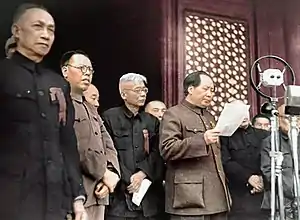| Part of a series on the |
| Chinese Communist Revolution |
|---|
 Proclamation of the People's Republic of China |
|
|
Sun–Joffe Manifesto or the Joint Manifesto of Sun and Joffe (孫文越飛宣言) was an agreement signed between Sun Yat-sen and Adolph Joffe on January 26, 1923, for the cooperation of Republic of China's Kuomintang and Soviet Union.[1] The manifesto asserted that the Soviet system was not suitable for China and announced in general terms the willingness of Soviet to co-operate with the KMT in its struggle to unify China.[2]
Background
In 1918, Georgy Chicherin of the Soviet Union Council of the People's Commissars announced Soviet intention to relinquish Russian rights and privileges acquired in China.[1] A formal note to open negotiations was sent to the Chinese Foreign Minister in Beijing on October 27, 1920. The Bolsheviks sent M.I. Yurin, Alexander Paikes and Adolph Joffe.[1]
Signing
Joffe would not settle the question of Outer Mongolia or the Chinese Far Eastern Railway[1] but was successful in establishing a political relations with Sun Yat-sen. On January 26, 1923, Sun and Joffe issued the manifesto, which became the foundation of co-operation between the Kuomintang and Soviet Union. In July 1923, Sun sent Chiang Kai-shek to Russia to study Soviet military and political conditions.[1] The Chinese Communist Party had been established only in July 1921, just a year before the signing. Sources have pointed out that the most crucial decision made in Sun's life to align the KMT with the Soviets and the Chinese Communists.[2]
See also
References
- 1 2 3 4 5 Tung, William L. [1968] (1968). The political institutions of modern China. Springer publishing. ISBN 9789024705528. p 92.
- 1 2 Howard, Richard C. Boorman, Howard L. Cheng, Joseph K. H. [1979] (1979). Biographical dictionary of Republican China, Volume 3. Columbia University Press. ISBN 9780231089579. p 182.